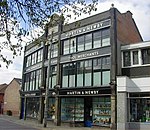St Clement's Church, Ipswich
Alexandra Ward, IpswichChurch of England church buildings in Ipswich

St Clement's Church, Ipswich, is a redundant church. The church is one of twelve medieval churches in Ipswich, six of which had been declared redundant by the 1970s. In the twenty-first century it was taken over by Ipswich Historic Churches Trust.The oldest parts of the church are fourteenth century, with additions from the fifteenth century, with substantial additions in the Tudor period to the tower and to the chancel in 1860 under the guidance of Frederick Barnes.For 500 years its congregation consisted primarily of the families of shipwrights, sailors, stevedores and merchants. Indeed, wool merchants funded the sixteenth century building of the tower.
Excerpt from the Wikipedia article St Clement's Church, Ipswich (License: CC BY-SA 3.0, Authors, Images).St Clement's Church, Ipswich
Woodbridge Road,
Geographical coordinates (GPS) Address Nearby Places Show on map
Geographical coordinates (GPS)
| Latitude | Longitude |
|---|---|
| N 52.0539 ° | E 1.1618 ° |
Address
Woodbridge Road 77
IP4 2RA , California
England, United Kingdom
Open on Google Maps









